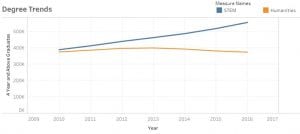The Gap Between STEM and Humanity Degrees: An Application of Network Effects
https://www.businessinsider.com/stem-majors-earn-a-lot-more-money-after-graduation-2014-7
As a student at Cornell, I’ve pretty much always been set on something in the STEM field ever since high school, as a result of the environment around me. Most of my classes in high school were more geared towards the mathematics and physical sciences, and my parents were both engineers. It didn’t help either when looking at the median salaries of STEM majors when compared to that of those with Humanity degrees. I’m sure these thoughts have also passed through other student’s eyes, and we can see from the statistics that there are significantly more STEM majors than Humanity majors (45% vs 1% in NY State). That’s an astronomical difference.
We can apply the idea of Network Effects to explain the discrepancy the number of majors of STEM vs non-STEM. Let r1(z) represent how much person z values a STEM major, and r2(z) represent the value that a non-STEM degree would provide given that the fraction of non-STEM majors would be z. Let’s also assume that f1(z) represents the demand for STEM-majors given that z is the fraction of STEM majors, and f2(z) represent the demand for non-STEM majors given that the fraction of non-STEM majors is z .
Ideally, we would want the two fractions to be equal, to promote a evenly distributed population. We would want to solve the following optimization non-linear program (if you are interested in this, you should check out some ORIE classes!).
minimize |z1 – z2|
subject to
p1 = r1(z1) * f2(z1)
p2 = r2(z2) * f2(z2)
decision variables p1, p2, z1, z2 >= 0
where z1 and z2 represent the fraction of STEM and non-STEM majors, respectively, and p1 and p2 represent the average salary of the two.
We can see from the system of equations that altering p1 would change z1 that satisfy the equation. Indeed, this makes sense intuitively because if the salary increases, more people would want to pursue STEM-majors, and if the salary decreases, less people would want to pursue the STEM-major. This argument also goes along with the non-STEM majors by symmetry. Thus, moving P1 and P2 closer together would bring z1 and z2 closer together, which is what we want. If we find equilibriums that would be difficult to achieve (due to downward pushes), we could attempt to prod people towards the equilibrium through different public statements.
Thus, our goal should be to try to make the salaries of STEM and non-STEM majors more similar, as this would help create more non-STEM majors. Intuitively, this makes sense because this would motivate students to worry less about salary, and more on their intrinsic interests.

